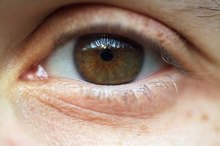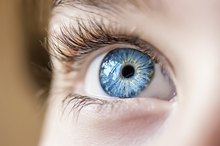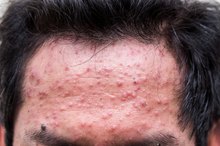Skin Disorders That Cause Pigment Loss
Pigment loss can be worrisome. It's sometimes limited to small patches of skin but may be more generalized. Understanding the nature of the pigment loss is key to determining the most appropriate next steps. Common causes of pigment loss include skin conditions like vitiligo, inflammation, wound healing with scarring, infection and a variety of other conditions that a person may be born with or acquire 10.
Vitiligo and Pityriasis Alba
Two of the most common skin disorders associated with pigment loss have causes that are not completely understood 5. Vitiligo typically occurs during the first 3 decades of life and is characterized by smooth, white patches of skin. Pityriasis alba, which is most often observed in young children, may first appear as a red scaly rash, typically on the face and arms. The rash often resolves spontaneously but leaves dry, white patches as it heals. These patches eventually disappear, causing no permanent pigment loss.
- Two of the most common skin disorders associated with pigment loss have causes that are not completely understood 5.
- Vitiligo typically occurs during the first 3 decades of life and is characterized by smooth, white patches of skin.
Infections
White Blotches on the Chest
Learn More
Several types of infection can cause pigment loss 78. Tinea versicolor, due to a fungus, is characterized by dry, scaly patches that may be lighter or darker than the surrounding skin and may itch. It may appear anywhere on the body and may be just a few spots or widespread. Pigment loss can also occur after certain viral infections like chickenpox.
- Several types of infection can cause pigment loss 7.
- Tinea versicolor, due to a fungus, is characterized by dry, scaly patches that may be lighter or darker than the surrounding skin and may itch.
Inflammation and Scarring
Pigment loss may occur after skin inflammation caused by disorders like psoriasis, lupus, seborrheic dermatitis and eczema. In all of these disorders, the pigment loss appears as irregular patches of poorly defined whitening, and there may be scaling if the underlying disorder is scaly. Pigment loss may also occur with scarring. This can make scars not only more noticeable but also susceptible to damage from ultraviolet radiation, leading to sunburns and possibly skin cancer.
- Pigment loss may occur after skin inflammation caused by disorders like psoriasis, lupus, seborrheic dermatitis and eczema.
- In all of these disorders, the pigment loss appears as irregular patches of poorly defined whitening, and there may be scaling if the underlying disorder is scaly.
Chemical Exposure and Topical Medicines
What Are the Causes of Eyelid Discoloration?
Learn More
Exposure to certain chemicals can cause skin color changes. For example, an antioxidant used in rubber manufacturing -- monobenzyl ether of hydroquinone -- was one of the first chemicals noted to be associated with occupation-related pigment loss. Certain compounds used in antioxidants or germicidal disinfectants can also produce pigment loss. Likewise, some medicines applied to the skin, such as corticosteroids and tretinoin, have the potential to produce lighter areas.
- Exposure to certain chemicals can cause skin color changes.
- For example, an antioxidant used in rubber manufacturing -- monobenzyl ether of hydroquinone -- was one of the first chemicals noted to be associated with occupation-related pigment loss.
Congenital and Genetic Conditions
Nevus depigmentosus is something akin to a freckle or mole that has no color. It's considered a congenital condition that a person is born with, but it has no known pattern of inheritance. Albinism is a group of genetic conditions associated with reduced pigment affecting the eyes and other areas, such as the skin and hair 7. Piebaldism, another genetic condition, usually results in a patch of white hair near the forehead, or a white forelock 8. There may also be areas of unpigmented skin on the forehead, trunk, arms and legs.
- Nevus depigmentosus is something akin to a freckle or mole that has no color.
- Albinism is a group of genetic conditions associated with reduced pigment affecting the eyes and other areas, such as the skin and hair 7.
Other Causes and Follow-Up
Inadequate intake of copper or selenium can cause generalized pigment loss, usually beginning on the face and sometimes also affecting the hair. This may occur in a person receiving long-term intravenous feeding or in instances of severely insufficient nutrient intake.
If you notice any pigment loss, see your doctor to help identify the cause and determine the most appropriate next steps. The pigment loss may be simply a part of a normal process, such as wound healing, but it may represent something more sinister, such as a melanoma changing from dark brown to flesh color.
- Inadequate intake of copper or selenium can cause generalized pigment loss, usually beginning on the face and sometimes also affecting the hair.
- The pigment loss may be simply a part of a normal process, such as wound healing, but it may represent something more sinister, such as a melanoma changing from dark brown to flesh color.
Related Articles
References
- Pediatric Dermatology: Pityriasis Alba Revisited: Perspectives on an Enigmatic Disorder of Childhood
- American Academy of Dermatology: Tinea Versicolor
- American Academy of Dermatology: Tinea Versicolor: Signs and Symptoms
- Acta Dermato-Venereologica: A Practical Classification of Childhood Hypopigmentation Disorders
- Preventing Occupational Disease and Injury; Barry S. Levy, ed
- Cutis: Piebaldism: A Case Report and a Concise Review of the Literature
- Journal of Cutaneous and Aesthetic Surgery: Hypomelanoses in Children
- Indian Journal of Plastic Surgery: Abnormal Pigmentation Within Cutaneous Scars: A Complication of Wound Healing
- Oculocutaneous albinism. Genetics Home Reference. US National Library of Medicine. 2019.
- Tsang SH, Sharma T (Editors). Atlas of Inherited Retinal Diseases. Springer. 2018.
- Tavakolizadeh S, Farahi A. Presence of fusion in albinism after strabismus surgery augmented with botulinum toxin (type a) injection. Korean J Ophthalmol. 2013;27(4):308-10. doi:10.3341/kjo.2013.27.4.308
- Wang Y, Wang Z, Chen M, et al. Mutational Analysis of the TYR and OCA2 Genes in Four Chinese Families with Oculocutaneous Albinism. PLoS ONE. 2015;10(4):e0125651. doi:10.1371/journal.pone.0125651
- Albinism. US National Library of Medicine. 2019.
- Rosenmann A, Bejarano-achache I, Eli D, Maftsir G, Mizrahi-meissonnier L, Blumenfeld A. Prenatal molecular diagnosis of oculocutaneous albinism (OCA) in a large cohort of Israeli families. Prenat Diagn. 2009;29(10):939-46. doi:10.1002/pd.2317
- Power B, Ferreira CR, Chen D, et al. Hermansky-Pudlak syndrome and oculocutaneous albinism in Chinese children with pigmentation defects and easy bruising. Orphanet J Rare Dis. 2019;14(1):52. doi:10.1186/s13023-019-1023-7
- Ocular albinism. Genetics Home Reference. US National Library of Medicine. 2019.
- Kronick B, John RM. Unseen Impairment: Pediatric Primary Care Management of Oculocutaneous Albinism 2. The Journal for Nurse Practitioners. 2016;12(8):516–522. doi:10.1016/j.nurpra.2016.07.001
- Albinism Fellowship.
- DiMicheli, K. Camille, MD. Albinism: What You Can do for Your Patients, Review of Ophthalmology, 11 Nov 2014.
- Kristin E. Noack Watt, Paul A. Trainor. "Oculocutaneous Albinism." Neural Crest Cells, 2014.
- Porter, Daniel. What Is Albinism? American Academy of Ophthalmology (AAO), 13 April 2018.
Resources
Writer Bio
Keren Price began medical writing in 1997. Over the years, she has written for a wide range of clients, including Medtronic, Salix Pharmaceuticals, and General Mills. Prior to her medical writing career, Price was the managing editor of the Journal of Nutrition Education. She earned a Bachelor of Science in biopsychology from Tufts University and a Master's degree in nutrition from Penn State.







